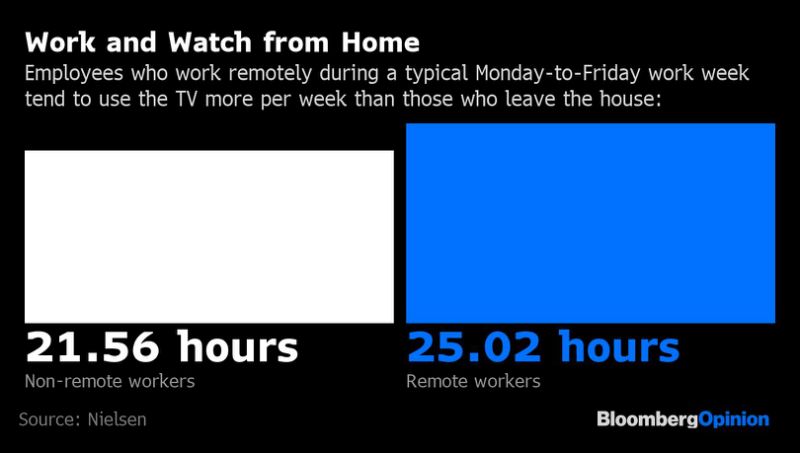(Bloomberg Opinion) — A few weeks ago, there was entirely too much TV content for Americans to watch and not enough hours in the day. How quickly it will start to feel as though just the opposite is true.
What’s on TV is a relatively minor concern in the grand scheme of things: The novel coronavirus is now present in every U.S. state, and more than 300 people in the country are known to have died as a result of Covid-19. At this rate, hospitals worry they’ll run out of space and life-saving equipment, and so Americans are being advised to hunker down to slow the spread. In this nationwide social-distancing experiment, media companies such as Comcast Corp., Netflix Inc. and Walt Disney Co. do have a role to play. The isolation will only get more difficult as the days wear on. Entertainment can help keep us from going stir-crazy and from giving in to the temptation to meet up with friends and go back to normal life.
Because this moment is so unprecedented, it’s hard to foresee the economic impact, other than that it will be painful, a pain that will be felt most severely by hourly workers. That can make conversations about what’s on Netflix feel tone-deaf. And still, it’s a very big part of how our consumption habits will change in the ensuing weeks and months. It doesn’t take a survey to know that when people are stuck home, TV viewership will go up. The closest Nielsen can get to predicting how much is to look at the aftermath of a natural disaster such as Hurricane Harvey, which devastated the Houston area in August 2017. It found that total television usage surged 56% in that market after that storm. Likewise, when a January 2016 blizzard dumped more than two feet of snow on New York, usage rose 45% and produced a 61% increase in streaming via TV.
At the same time, the surge in demand may expose more of the industry’s problems. Sports programming is the biggest reason to still pay for traditional cable TV, but for the moment there aren’t any live sports to watch. The NBA, NHL, MLB and other leagues have all postponed or canceled games because of the virus (and so ESPN is having to get creative). The pandemic may in turn drive more households to ditch the $100-plus cable bundle and switch to streaming-TV services such as Disney+, Apple TV+ and (soon) HBO Max. But as much as these services brag about the thousands of hours of movies and shows they have, which sounds like a lot, the truth is that people may grow bored with any of these apps relatively quickly when forced to spend so much extra time with one.
All of the media giants have been spending like mad during the last year on content to stock their new streaming apps, including expensive rights deals for access to re-runs of old favorites such as “Seinfeld” and “Friends.” That there isn’t enough to watch will be more of a feeling than a reality, but it speaks to the growing frustration with the new TV ecosystems that are being created independent of one another.
In my own 11 days of isolation, much of it under the weather, I’ve run out of Netflix titles — not literally, but after endless scrolling and previewing, there doesn’t seem to be anything left that I want to see or can force myself to sit through. More content is being added to Netflix all the time, and normally that’s enough, but the five-day wait for the next season of “Ozark” suddenly feels like torture. Disney+ subscribers who signed up for and finished the first season of “The Mandalorian” are probably getting antsy, too, given that there’s not much else like it on the service. It announced Friday, though, that Pixar’s “Onward” was made available early on demand for $20 and that it will be added to the Disney+ library April 3. Meanwhile, the outbreak has forced studios to halt production of upcoming programs.
Comcast’s Universal is also making current film releases “The Invisible Man,” “Emma” and “The Hunt” available to rent on demand for $20 each since theaters are closed or closing. Those who can afford Amazon Prime at $119 a year have access to another bucket of content, and the free shipping may come in handy in the online hunt for toilet paper and antibacterial wipes. But in a recession, the already tense pricing dynamics of the streaming industry will be put to the test. In theory, streaming is a more affordable alternative to cable. The problem, as ever, is that everyone’s favorite content is being spread out behind different paywalls, and that won’t be much help for families feeling financial strain. Those facing the prospect of lost jobs or lost work hours won’t have the luxury of subscribing to everything.
There’s also the increasingly precious home-internet bandwidth. Already in Europe, Netflix, Amazon’s Prime Video and Google’s YouTube have all agreed to temporarily reduce the speed of their streams to avoid overloading networks while so many people are working from home.
It could be that the extra time to binge on content leads to higher churn than the companies were previously expecting. Perhaps it increases the appeal of free, ad-supported apps such as Pluto TV (owned by ViacomCBS Inc.), Tubi (which just sold to Fox Corp.) and Comcast’s soon-to-come Peacock. Was it a mistake for other streaming services not to pursue free, ad-supported viewing options given that there’s now an even bigger captive audience? Or is some advertiser demand drying up because people will be doing far less shopping while trapped indoors on tighter budgets?
For now, there are more questions than answers. But consumer behavior will be interesting to observe as the streaming experiment meets the social-distancing experiment. Just don’t forget to wipe down the remote every so often.
This column does not necessarily reflect the opinion of Bloomberg LP and its owners.
Tara Lachapelle is a Bloomberg Opinion columnist covering the business of entertainment and telecommunications, as well as broader deals. She previously wrote an M&A column for Bloomberg News.
<p class="canvas-atom canvas-text Mb(1.0em) Mb(0)–sm Mt(0.8em)–sm" type="text" content="For more articles like this, please visit us at bloomberg.com/opinion” data-reactid=”57″>For more articles like this, please visit us at bloomberg.com/opinion
<p class="canvas-atom canvas-text Mb(1.0em) Mb(0)–sm Mt(0.8em)–sm" type="text" content="Subscribe now to stay ahead with the most trusted business news source.” data-reactid=”58″>Subscribe now to stay ahead with the most trusted business news source.
©2020 Bloomberg L.P.








